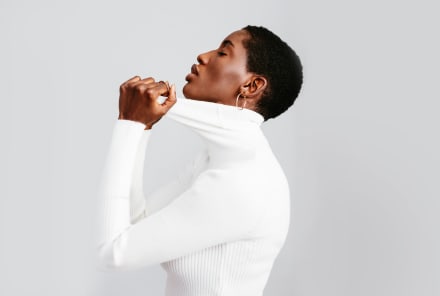Advertisement
How To Use The Box Breath To Call In Calm & Focus On Demand


Box breathing is a way to manipulate your breath to promote focus and relieve stress. Here's an overview of how to get comfortable with this breathwork sequence and use it to call in calm on demand.
What is box breathing?
Box breathing—also known as square breathing and 4-4-4-4 breathing—is a breathwork first popularized by Navy SEALs who used it to quickly sharpen concentration and enhance alertness. It requires inhaling for four counts, holding your breath for four counts, exhaling for four counts, and then holding your breath again for four counts.
Box breathing gets its name from this four-sided pattern (inhale, hold, exhale, hold). While some breaths are suitable for an everyday practice, researcher of pulmonary medicine and author of Breath Taking Michael J. Stephen, M.D., says this isn't one of them. "There's a reason Marines and athletes embrace the box breath," he tells mbg. "All of the ratios are 1-1-1-1, and that's very unusual for breathwork. It's not a circle; it's a sharp angle."
For this reason, he says to save it for moments when you need a quick hit of calm, like right before a big presentation, and reserve your daily practice for gentler sequences like alternate nostril breathing or extended exhale breathing.
How to do the box breath.
To practice this breath, find a seated position and close your eyes. Then, follow along with the following video or written explainer:
- Inhale through the nose for 4 seconds. Feel your lungs gradually fill with air as you go.
- Hold your breath for 4 seconds. Once your lungs are filled with air, hold your breath.
- Exhale out of the mouth for 4 seconds. Try to exhale at the same rate that you inhaled.
- Hold your breath for 4 seconds. Once your lungs are empty, hold your breath again. This is the most intense part of this breath sequence, and it will feel unnatural at first. Be gentle with yourself, and start slow. Those who are new to the breath might find it helpful to place one hand on the belly and another on the heart for some tactile feedback as they go.
- Continue for 60 seconds or more. Start by repeating this sequence four times—which will bring you to one minute of controlled breath. From there, feel free to work your way up to longer sessions, but stay under the 20-minute mark to avoid lightheadedness.
Box breathing variations:
Using this traditional sequence as a jumping-off point, you can get creative and make the breath your own with the following ideas:
- Feel free to switch up the amount of time you spend on each step. If you're new to breathwork, a 2-2-2-2 sequence might feel like a better entryway. If you're an old pro, you might challenge yourself to a 6-6-6-6.
- Breathwork teacher and mbg class instructor Gwen Dittmar likes to assign a mental image to each part of the sequence. On the inhale, she imagines grounding earth element filling her body; on the first hold, she imagines wind sweeping negative thoughts from her mind; on the exhale, she imagines the fire element roaring her love out into the universe; and on the second hold she imagines water guiding her through the waves of life.
- Assign a particular color or sound to each part of the sequence, or picture yourself absorbing prosperity and releasing scarcity with every inhale and exhale.
Benefits of box breathing.
It's relaxing.
Dittmar recommends using this particular breathing technique when you need to feel relaxed yet alert. "I like to use this technique before difficult conversations or if I want to feel more focused when I go into a meeting," she says in her mbg class, The Ultimate Guide to Breathwork. "This is also really great for when you're in a stressful situation and you need to be present but also want to be calm."
It focuses the mind.
"Along with training more powerful breathing musculature, it slows down your breathing rate and deepens your concentration skills," author and former Navy SEAL Mark Divine previously wrote of his experience with box breathing on mbg.
It's good for the lungs.
Stephen says that slow, deep breathing can help us "engage our diaphragm, get air into the lower part of our lungs, and really stretch out our alveoli—the gas exchange units of our lungs." He's even seen breathwork be an effective adjunct therapy for patients with lung diseases like COPD and asthma.
It relieves stress.
Stephen explains that breathwork sequences like the box breath stimulate the vagus nerve, which send signals to the brain that it's safe to calm down. He points to research that has found breathwork can help reduce depression and anxiety symptoms in asthma patients and promote emotional control and psychological well-being1 in the greater population.
Stephens likens taking deep, controlled breaths to pumping the breaks on overwhelm, stress, and anxiousness. "We don't have access to the accelerator, and sometimes that goes off the handle," he says, "but we do have access to the brake."
The takeaway.
Box breathing can deliver a powerful rush of calm and focus—but the technique might feel a little uncomfortable at first. Be gentle, take things slow, and over time you might just have a new favorite stress-relief tool on your hands.

















